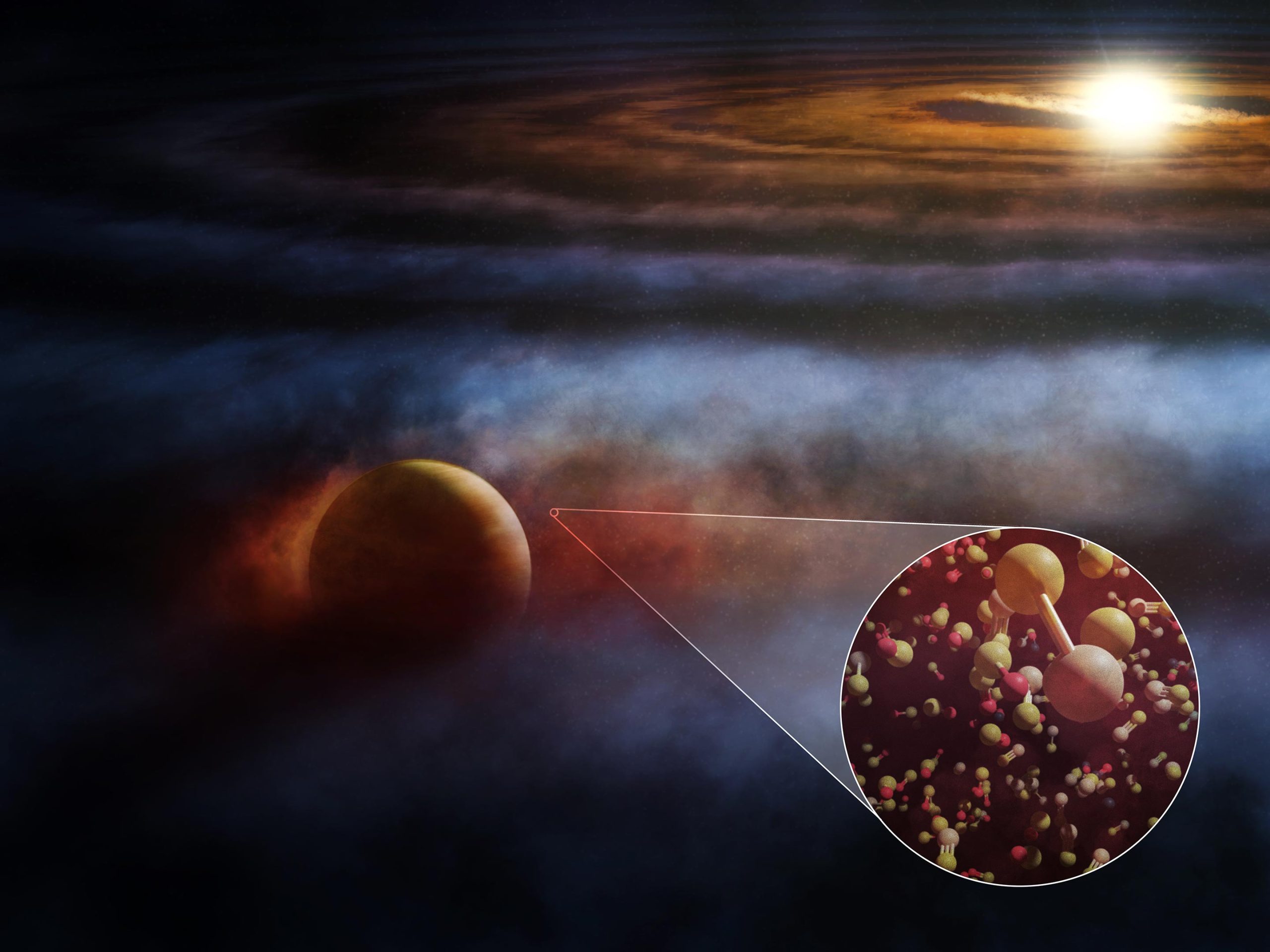Ubicada en la constelación de Sagitario, la joven estrella HD 169142 alberga un protoplaneta gigante incrustado dentro de su polvoriento disco protoplanetario lleno de gas. La concepción de este artista muestra al planeta similar a Júpiter interactuando y calentando el gas molecular cercano, lo que lleva a los flujos de salida que se observan en varias líneas de emisión, incluidas las de partículas trazadoras de impacto como SO y SiS, 12CO y 13CO. Crédito: ALMA (ESO/NAOJ/NRAO), M. Weiss (NRAO/AUI/NSF)
usando[{» attribute=»»>ALMA observatory, scientists studying the protoplanetary disk around young star HD 169142 have discovered strong chemical evidence of a protoplanet, offering a new method for detecting and studying these celestial bodies. The detection of silicon monosulfide, indicative of a gas giant protoplanet, provides a novel insight into protoplanetary chemistry.
Scientists using the Atacama Large Millimeter/submillimeter Array (ALMA) to study the protoplanetary disk around a young star have discovered the most compelling chemical evidence to date of the formation of protoplanets. The discovery will provide astronomers with an alternate method for detecting and characterizing protoplanets when direct observations or imaging are not possible. The results will be published in an upcoming edition of The Astrophysical Journal Letters.
HD 169142 is a young star located in the constellation Sagittarius that is of significant interest to astronomers due to the presence of its large, dust- and gas-rich circumstellar disk that is viewed nearly face-on. Several protoplanet candidates have been identified over the last decade, and earlier this year, scientists at the University of Liège and Monash University confirmed that one such candidate — HD 169142 b — is, in fact, a giant Jupiter-like protoplanet.
The discoveries revealed in a new analysis of archival data from ALMA — an international collaboration in which the National Science Foundation’s National Radio Astronomy Observatory (NRAO) is a member— may now make it easier for scientists to detect, confirm, and ultimately characterize, protoplanets forming around young stars.
“When we looked at HD 169142 and its disk at submillimeter wavelengths, we identified several compelling chemical signatures of this recently-confirmed gas giant protoplanet,” said Charles Law, an astronomer at the Center for Astrophysics | Harvard & Smithsonian, and the lead author of the new study. “We now have confirmation that we can use chemical signatures to figure out what kinds of planets there might be forming in the disks around young stars.”
The team focused on the HD 169142 system because they believed that the presence of the HD 169142 b giant protoplanet was likely to be accompanied by detectable chemical signatures, and they were right. Law’s team detected carbon monoxide (both 12CO and its isotopologue 13CO) and sulfur monoxide (SO), which had previously been detected and were thought to be associated with protoplanets in other disks.
But for the first time, the team also detected silicon monosulfide (SiS). This came as a surprise because in order for SiS emission to be detectable by ALMA, silicates must be released from nearby dust grains in massive shock waves caused by gas traveling at high velocities, a behavior typically resulting from outflows that are driven by giant protoplanets.
“SiS was a molecule that we had never seen before in a protoplanetary disk, let alone in the vicinity of a giant protoplanet,” Law said. “The detection of SiS emission popped out at us because it means that this protoplanet must be producing powerful shock waves in the surrounding gas.”
With this new chemical approach for detecting young protoplanets, scientists may be opening a new window on the Universe and deepening their understanding of exoplanets. Protoplanets, especially those that are still embedded in their parental circumstellar disks such as in the HD 169142 system, provide a direct connection with the known exoplanet population.
“There’s a huge diversity in exoplanets and by using chemical signatures observed with ALMA, this gives us a new way to understand how different protoplanets develop over time and ultimately connect their properties to that of exoplanetary systems,” said Law.
“In addition to providing a new tool for planet-hunting with ALMA, this discovery opens up a lot of exciting chemistry that we’ve never seen before. As we continue to survey more disks around young stars, we will inevitably find other interesting but unanticipated molecules, just like SiS. Discoveries such as this imply that we are only just scratching the surface of the true chemical diversity associated with protoplanetary settings.”
Reference: “SO and SiS Emission Tracing an Embedded Planet and Compact 12CO and 13CO Counterparts in the HD 169142 Disk” by Charles J. Law, Alice S. Booth, Karin I. Öberg, Accepted, The Astrophysical Journal Letters.
arXiv:2306.13710
The National Radio Astronomy Observatory (NRAO) is a major facility of the National Science Foundation (NSF) operated under a cooperative agreement by Associated Universities, Inc.

«Viajar ninja. Alborotador. Erudito del tocino. Experto en alcohol extremo. Defensor de los zombis».







More Stories
Los legionarios realizan dos cruceros separados vinculados a esta característica especial de lujo: informe
La supernova vista por primera vez en 1181 libera filamentos brillantes
SpaceX lanza 20 satélites de Internet Starlink desde California el 30 de octubre